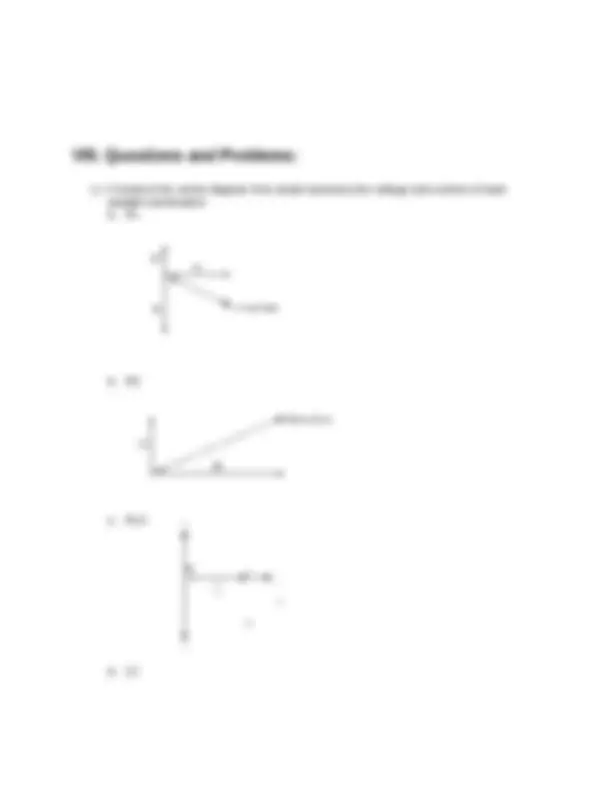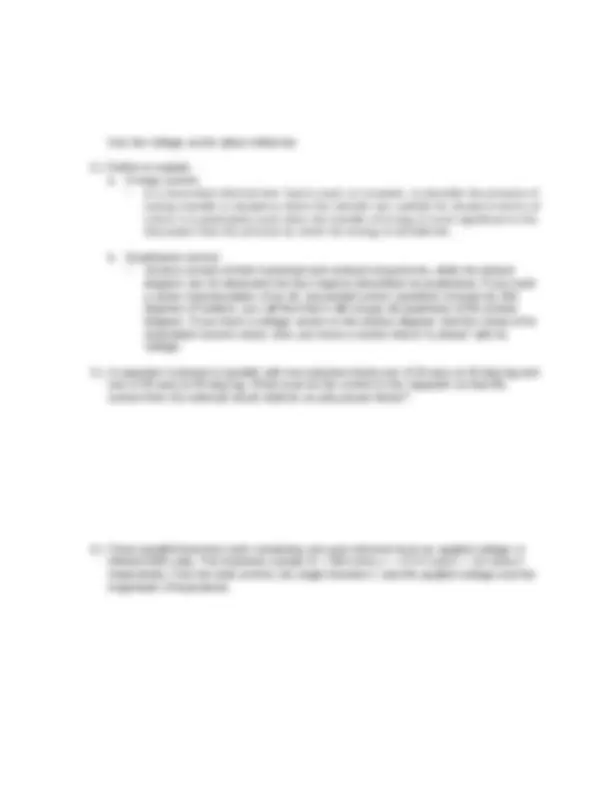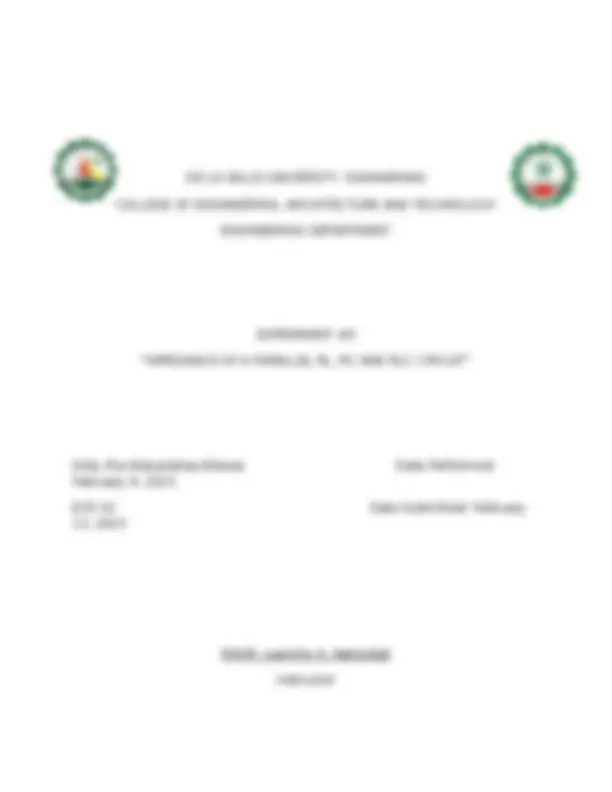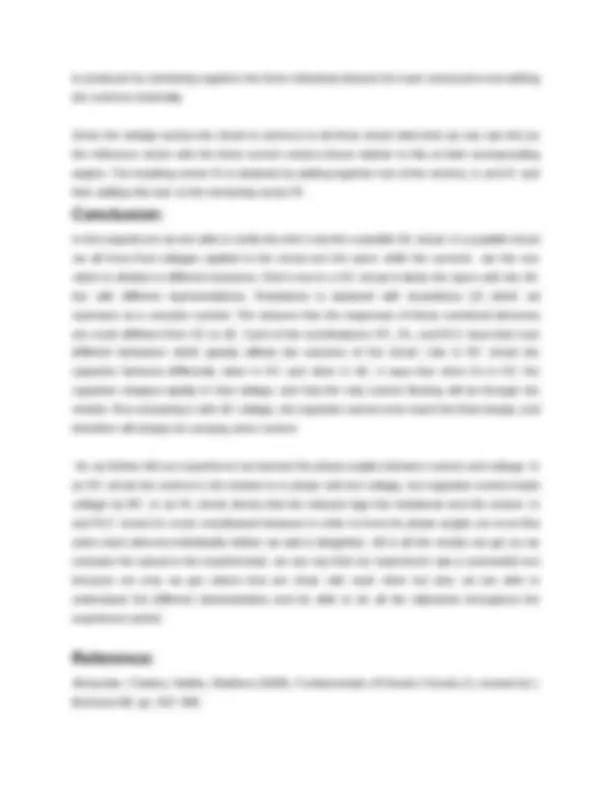







Study with the several resources on Docsity

Earn points by helping other students or get them with a premium plan


Prepare for your exams
Study with the several resources on Docsity

Earn points to download
Earn points by helping other students or get them with a premium plan
Community
Ask the community for help and clear up your study doubts
Discover the best universities in your country according to Docsity users
Free resources
Download our free guides on studying techniques, anxiety management strategies, and thesis advice from Docsity tutors
There are three basic, linear passive lumped analog circuit components: the resistor (R), the capacitor (C), and the inductor (L). These may be combined in the RC circuit, the RL circuit, the LC circuit, and the RLC circuit, with the abbreviations indicating which components are used. These circuits, among them, exhibit a large number of important types of behavior that are fundamental to much of analog electronics. In particular, they are able to act as passive filters.
Typology: Study Guides, Projects, Research
1 / 9

This page cannot be seen from the preview
Don't miss anything!






Circuit Impedance Z = 83.8 Ω (magnitude only) magnitude only) ) Phase Angle θ = Arc cos
= 24.78° (magnitude only) in degrees) Calculated IS = 0.72 amp; Measured IS = 0.71 amp Calculated IR = 0.65 amp; Measured IR = 0.7 amp Calculated IL = 0.3 amp; Measured IL = 0.3 amp
Circuit Impedance Z = 157.68 Ω (magnitude only) magnitude only) ) Phase Angle θ = Arc cos
= 23.10° (magnitude only) in degrees) Calculated IS = 0.76 amp; Measured IS = 0.761 amp Calculated IR = 0.699 amp; Measured IR = 0.7 amp Calculated IC = 0.299 amp; Measured IC = 0.3 amp
Circuit Impedance Z = 83.87 Ω (magnitude only) magnitude only) ) Phase Angle θ = Arc cos
= 24.68° (magnitude only) in degrees) Calculated IS = 1.192 amp; Measured IS = 1.225 amp Calculated IR = 1.083 amp; Measured IR = 1.084 amp Calculated IL = 0.332 amp; Measured IL = 0.330 amp Calculated IC = 0.829 amp; Measured IC = 0.830 amp
Circuit Impedance Z = 83.8 Ω (magnitude only) magnitude only) ) Phase Angle θ = Arc cos
= 24.78° (magnitude only) in degrees) Calculated IS = 0.72 amp; Measured IS = 0.759 amp Calculated IR = 0.65 amp; Measured IR = 0.651 amp Calculated IL = 0.3 amp; Measured IL = 0.294 amp
Circuit Impedance Z = 157.68 Ω (magnitude only) magnitude only) ) Phase Angle θ = Arc cos
= 23.10° (magnitude only) in degrees) Calculated IS = 0.76 amp; Measured IS = 0.792 amp Calculated IR = 0.699 amp; Measured IR = 0.716 amp Calculated IC = 0.299 amp; Measured IC = 0.319 amp
Circuit Impedance Z = 83.87 Ω (magnitude only) magnitude only) ) Phase Angle θ = Arc cos
= 24.68° (magnitude only) in degrees) Calculated IS = 1.192 amp; Measured IS = 1.199 amp Calculated IR = 1.083 amp; Measured IR = 1.097 amp Calculated IL = 0.332 amp; Measured IL = 0.337 amp Calculated IC = 0.829 amp; Measured IC = 0.617 amp
Use the voltage as the place reference 2.) Define or explain. a. Energy) current
impedance will change with frequency) , since that helps determine XL, but for any) given frequency) , it will not change over time. Since the resistor and inductor are connected in parallel, the input voltage is equal to output voltage but the currents flowing in resistor and inductor are different. The parallel RL circuit is not used as filter for voltages because in this circuit, the output voltage is equal to input voltage and for this reason it is not commonly) used as compared to series RL circuit. and shows that the inductor lags the resistor (magnitude only) and source) current by) 90°. The Parallel RLC Circuit is the exact opposite to the series circuit. This time instead of the current being common to the circuit components, the applied voltage is now common to all so we need to find the individual branch currents through each element. The total impedance, Z of a parallel RLC circuit is calculated using the current of the circuit similar to that for a DC parallel circuit, the difference this time is that admittance is used instead of impedance. Parallel RLC circuit is said to have dual relationship with series RLC circuit. The total current, IS drawn from the supply) is equal to the vector sum of the resistive, inductive and capacitive current, not the mathematic sum of the three individual branch currents, as the current flowing in resistor, inductor and capacitor are not in same phase with each other; so they) cannot be added arithmetically). Like the series RLC circuit, we can solve this circuit using the phasor or vector method but this time the vector diagram will have the voltage as its reference with the three current vectors plotted with respect to the voltage. The phasor diagram for a parallel RLC circuit
is produced by) combining together the three individual phasors for each component and adding the currents vectorially). Since the voltage across the circuit is common to all three circuit elements we can use this as the reference vector with the three current vectors drawn relative to this at their corresponding angles. The resulting vector IS is obtained by) adding together two of the vectors, IL and IC and then adding this sum to the remaining vector IR.
In this experiment we are able to verify) the ohm’s law for a parallel AC circuit. In a parallel circuit we all know that voltages applied to the circuit are the same while the currents are the one which is divided in different branches. Ohm’s law in a DC circuit is likely) the same with the AC but with different representations. Resistance is replaced with impedance (magnitude only) Z) which we represent as a complex number. We observe that the responses of these combined elements are much different from DC to AC. Each of the combinations: RC, RL, and RLC have their own different behaviors which greatly) affects the outcome of the circuit. Like in RC circuit the capacitor behaves differently) when in DC and when in AC, it say) s that when it’s in DC the capacitor charges rapidly) to that voltage, and that the only) current flowing will be through the resistor. But comparing it with AC voltage, the capacitor cannot even reach the final charge, and therefore will alway) s be carry) ing some current. As we further did our experiment we learned the phase angles between current and voltage. In an RC circuit the current in the resistor is in phase with the voltage, but capacitor current leads voltage by) 90°, in an RL circuit shows that the inductor lags the resistance and the source. In and RLC circuit it’s much complicated because in order to know its phase angles we must first solve each element individually) before we add it altogether. All in all the results we got as we compare the actual to the experimental, we can say) that our experiment was a successful one because not only) we got values that are close with each other but also we are able to understand the different characteristics and be able to do all the objectives throughout the experiment period.
Alexander, Charles; Sadiku, Matthew (magnitude only) 2006). Fundamentals of Electric Circuits (magnitude only) 3, revised ed.). McGraw-Hill. pp. 387–389.